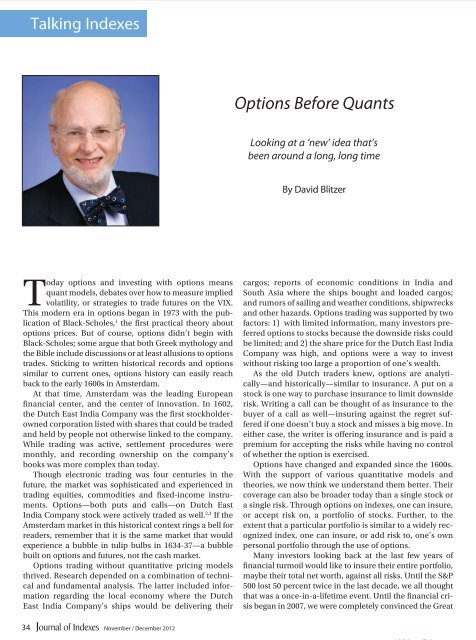Download complete issue - IndexUniverse.com
Download complete issue - IndexUniverse.com
Download complete issue - IndexUniverse.com
You also want an ePaper? Increase the reach of your titles
YUMPU automatically turns print PDFs into web optimized ePapers that Google loves.
Talking Indexes<br />
Options Before Quants<br />
Looking at a ‘new’ idea that’s<br />
been around a long, long time<br />
By David Blitzer<br />
Today options and investing with options means<br />
quant models, debates over how to measure implied<br />
volatility, or strategies to trade futures on the VIX.<br />
This modern era in options began in 1973 with the publication<br />
of Black-Scholes, 1 the first practical theory about<br />
options prices. But of course, options didn’t begin with<br />
Black-Scholes; some argue that both Greek mythology and<br />
the Bible include discussions or at least allusions to options<br />
trades. Sticking to written historical records and options<br />
similar to current ones, options history can easily reach<br />
back to the early 1600s in Amsterdam.<br />
At that time, Amsterdam was the leading European<br />
financial center, and the center of innovation. In 1602,<br />
the Dutch East India Company was the first stockholderowned<br />
corporation listed with shares that could be traded<br />
and held by people not otherwise linked to the <strong>com</strong>pany.<br />
While trading was active, settlement procedures were<br />
monthly, and recording ownership on the <strong>com</strong>pany’s<br />
books was more <strong>com</strong>plex than today.<br />
Though electronic trading was four centuries in the<br />
future, the market was sophisticated and experienced in<br />
trading equities, <strong>com</strong>modities and fixed-in<strong>com</strong>e instruments.<br />
Options—both puts and calls—on Dutch East<br />
India Company stock were actively traded as well. 2,3 If the<br />
Amsterdam market in this historical context rings a bell for<br />
readers, remember that it is the same market that would<br />
experience a bubble in tulip bulbs in 1634-37—a bubble<br />
built on options and futures, not the cash market.<br />
Options trading without quantitative pricing models<br />
thrived. Research depended on a <strong>com</strong>bination of technical<br />
and fundamental analysis. The latter included information<br />
regarding the local economy where the Dutch<br />
East India Company’s ships would be delivering their<br />
cargos; reports of economic conditions in India and<br />
South Asia where the ships bought and loaded cargos;<br />
and rumors of sailing and weather conditions, shipwrecks<br />
and other hazards. Options trading was supported by two<br />
factors: 1) with limited information, many investors preferred<br />
options to stocks because the downside risks could<br />
be limited; and 2) the share price for the Dutch East India<br />
Company was high, and options were a way to invest<br />
without risking too large a proportion of one’s wealth.<br />
As the old Dutch traders knew, options are analytically—and<br />
historically—similar to insurance. A put on a<br />
stock is one way to purchase insurance to limit downside<br />
risk. Writing a call can be thought of as insurance to the<br />
buyer of a call as well—insuring against the regret suffered<br />
if one doesn’t buy a stock and misses a big move. In<br />
either case, the writer is offering insurance and is paid a<br />
premium for accepting the risks while having no control<br />
of whether the option is exercised.<br />
Options have changed and expanded since the 1600s.<br />
With the support of various quantitative models and<br />
theories, we now think we understand them better. Their<br />
coverage can also be broader today than a single stock or<br />
a single risk. Through options on indexes, one can insure,<br />
or accept risk on, a portfolio of stocks. Further, to the<br />
extent that a particular portfolio is similar to a widely recognized<br />
index, one can insure, or add risk to, one’s own<br />
personal portfolio through the use of options.<br />
Many investors looking back at the last few years of<br />
financial turmoil would like to insure their entire portfolio,<br />
maybe their total net worth, against all risks. Until the S&P<br />
500 lost 50 percent twice in the last decade, we all thought<br />
that was a once-in-a-lifetime event. Until the financial crisis<br />
began in 2007, we were <strong><strong>com</strong>plete</strong>ly convinced the Great<br />
34<br />
November / December 2012

















